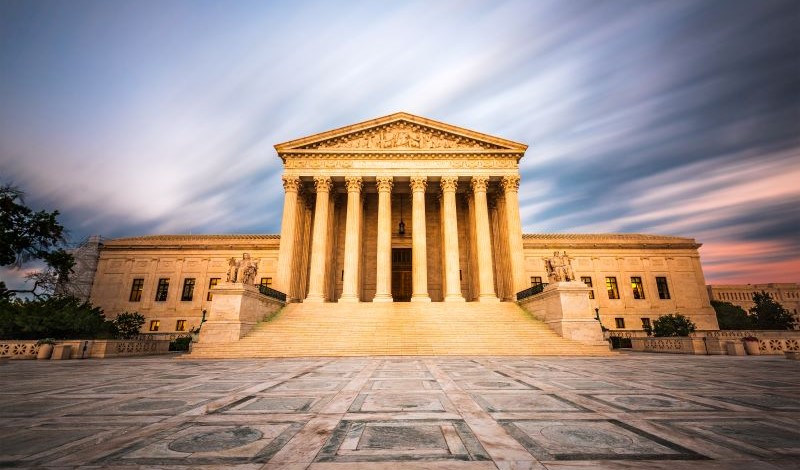
President Trump’s removal of agency heads without cause threatens the rule of law.
The judges of the U.S. Court of Appeals for the D.C. Circuit who recently stayed a lower court injunction that temporarily blocked the removal of members of the National Labor Relations Board (NLRB) and the Merit Systems Protection Board (MSPB) are living in a dream world. In this world, the President uses his executive power to faithfully execute the law. According to at least Judge Justin R. Walker, one of the judges who voted to stay the injunction, any judicial order even temporarily restraining the President constitutes an emergency justifying an immediate stay. Even though the order issued by the lower court simply enforced statutes that demanded that members of independent agencies keep their positions unless there is some good cause justifying removal. Thankfully, the D.C. Circuit as a whole reinstated the lower court injunction. It remains to be seen whether Trump’s assault on the rule of law will awaken the U.S. Supreme Court or whether the Court will continue to issue emergency orders hindering the lower courts’ efforts to preserve the rule of law as they sort through the issues Trump’s assault on the U.S. Constitution raises.
It is quite apparent that President Donald J. Trump is firing agency heads to disable the many laws he disapproves of. This fact is especially obvious with respect to the National Labor Relations Act (NLRA), for the firing of NLRB member Gwynn Wilcox deprives the NLRB of the quorum needed to do business. It is also apparent from the reason President Trump gave for removing Wilcox. He claimed that Wilcox was “unduly disfavoring the interests of employers.” But the U.S. Congress enacted the NLRA precisely to strengthen labor’s ability to form unions and collectively bargain. Congress did not enact the NLRA to protect the interests of big business.
President Trump is also trying to undermine civil services laws. President Trump gave no reason for removing Cathy Harris from the MSPB, which hears cases challenging the removal of agency employees under the civil service laws. But other actions make it obvious that President Trump is trying to dismantle the legal protections that Congress and previous Presidents created for civil servants. The aim here is to substitute incompetent yes-men—and women—for a competent administration aimed at carrying out the laws’ purposes. This goal is obvious from the mass firing of civil servants and the nomination of inexperienced loyalists to head government agencies.
Indeed, anyone who reads the newspapers should understand that President Trump is attacking the U.S. Constitution as a whole and the rule of law it supports. He usurps the power of Congress over the purse by unilaterally defunding programs he does not like, thereby turning whole statutes into dead—or weakened—letters. When the President refuses to spend the money Congress appropriated to support programs and fires the people who are faithfully administering statutes, the President defeats faithful law execution and substitutes presidential control over policy for legislative control. He becomes a dictator.
In fairness to Judge Walker and Judge Karen LeCraft Henderson, who also voted to stay the order temporarily reinstating Harris and Wilcox, they did not invent this dream world. The Supreme Court did. In Seila Law v. Consumer Financial Protection Bureau, the Supreme Court conceived of power to effectuate arbitrary removal as somehow serving the rule of law. None of the Justices have even considered the possibility that a President can abuse wholly unlimited removal authority to prevent faithful execution of the law and to attack liberty. The D.C. Circuit’s views of the likelihood of success on the merits rightly takes into account the Supreme Court’s dream world, which may soon come in to play if the case reaches the Court
But an emergency stay order also requires an assessment of the public interest and the balance of equities. It is odd to have the court say, in effect, that the public interest demands immediately firing officials who have not been accused of misapplying the law but instead of not being aligned with the President’s desire to dictate policy unilaterally. Judge Walker’s reasoning treats any temporary setback for any presidential desire as an irreparable harm requiring an emergency remedy. It identifies no presidential policy being served here, and it ignores the Constitution’s vesting of policymaking authority in Congress. It also claims that a stay serves the public interest by preventing the disenfranchisement of voters who supported President Trump. But that reasoning would suggest that equities always favor the President even as he establishes a dictatorship and inflicts permanent harm on others.
The judges point to no evidence that President Trump’s supporters voted to dismantle labor protections or the civil service. But even if his supporters voted for that, President Trump has no constitutional power to dismantle laws. He can only legitimately ask Congress to do that.
The power to remove officials arbitrarily creates a powerful weapon to dismantle the rule of law. If a President can unreasonably remove officials, he can remove them for resisting an order to disobey the law or infringe upon constitutional rights. He can repeal a statute unilaterally by simply firing all those who would obey their oaths of office.
If the case proceeds further, the Supreme Court needs to take the potential of the unitary executive theory to undermine or even destroy constitutional democracy into account. It may help explain why there is no evidence that the drafters of the Constitution ever endorsed a power to remove officials arbitrarily and that arbitrary removal, although rare, has often been used to prevent—not carry out—faithful law execution. President Andrew Jackson used it to undermine the national bank, incurring a censure. President Andrew Johnson removed numerous officials to prevent implementation of newly passed civil rights laws, suffering impeachment as a result. President Richard M. Nixon removed officials to cover up Watergate and faced almost certain impeachment before he resigned. And President Trump’s numerous removals in his first term facilitated massive legal violations, causing him to lose some 90 percent of his immigration cases.
For-cause removal allows a President to get rid of officials who do not properly implement law. Unlimited removal authority makes removal a potential tool to defeat the rule of law. We can only hope that if the Supreme Court eventually takes up the case, they wake up and leave the dream world.




